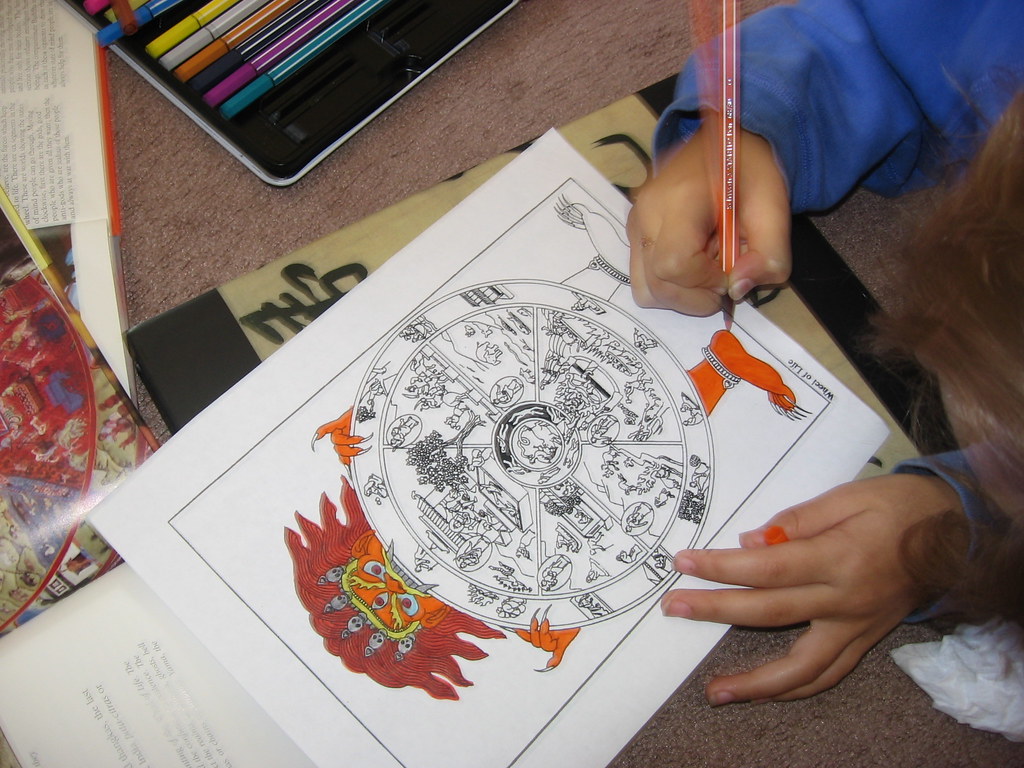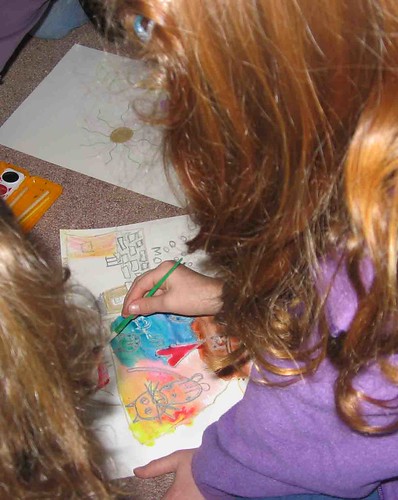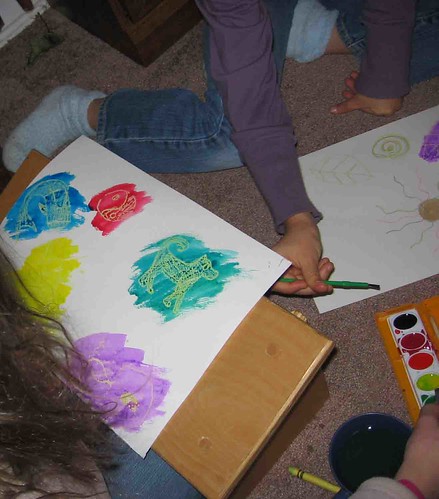Some traditions and teachers of the Dharma come across as stodgy and stiff. Perhaps it is in the translations, or it is a flavor of Buddhism that has been passed down that emphasizes tradition and rules. Personally I wilt in in the face of that schoolmarm severity. When the Dharma comes across as exclusive and unattainable, I am inclined to give up before I start. In our tradition though, I find much encouragement. This practice is not out of reach for the regular person, or for a child. I would not be inclined to share this definition of Virya with my class:
Virya is another noble virtue which all men of high endeavour must zealously cultivate. Unless a man is fearless, brave and active he can never accomplish a difficult task. A man is prey to fears, who always tries to save his skin, who is afraid of consequences, is a very poor specimen of humanity. He dies without any accomplishment to his credit. A man who is assailed by fear is a man who has no faith in Dhamma. Found here.
That may be true, but only certain types of people are inspired to zealously cultivate the Dharma from that. May that work for them. I doubt that would work for most grade school girls.
On the other hand, I completely relate to "the perfection of joyous effort, or enthusiastic perseverance."
Found here. (Follow that link for some good stuff on how virya manifests.) This web author said, "From a feeling of deep compassion for the suffering of all sentient beings, we are urged to unfailing, persistent, and joyous effort. We use our body, speech, and mind to work ceaselessly and untiringly for the benefit of others, with no expectations for personal recognition or reward."
By getting various takes on this paramita of persistent effort, I made the connection to bowing. Bowing unites body and mind in an expression of respect, love, and effort. When one does a lot of bowing practice, the body moves with a fluid grace and one experiences an attitude of openness, compassion, and willingness. A perfect expression of virya would have that same open attitude and willing body and mind, so I made this lesson about bowing. Bowing is a preparation for mind-opening concentration, bowing takes effort, and bowing expresses the willingness to set aside ego, the very effort needed for this Buddhist practice.
Lama Surya Das said
here, "Now I see bowing as an elegant traffic signal of the body, voice, and mind. Every bow says: Slow down. Drop the ego. Meditation zone ahead. Proceed with cushion. Bowing is a mindfulness practice. It is a way of removing our mental and emotional armor, along with other ego baggage we may be burdened with." When it comes to bowing gracefully, sometimes the virya needed is more about persistence than about joy...but when you find that joy in effort, it is easy to persist.
So, for this our second lesson in January, I concentrated on bowing for our meditation practice. After we meditated about 5 minutes, Jyoshin and I instructed the girls on the technique of full bows. Jyoshin demonstrated.

Photo by Richard Seah.
Found here.For the sake of time and space, the girls made three full bows. I would have liked to have them do nine.
Boys aren't the only ones interested in Extreme Effort; I knew the girls would be impressed by some of the bowing practices that some traditions do. For instance in Korean Zen, Jyoshin and I were both aware people do 108 full bows, first thing in the morning. I discovered and shared with the girls that some people complete 1080 bows daily. I also shared that a foundational beginning practice for many Tibetan Buddhist practitioners is to complete 111,000 bows.
Then there are people who go on pilgrimages. Three steps, one bow. Such diligent and difficult effort amazes me, and amazed the girls. I read to them some excerpts from "With One Heart, Bowing to the City of the 10,000 Buddhas." I told them I'm sure I've heard of more people undertaking such pilgrimages since then (1977) but I knew they would like these stories. I explained that when these two young bowed their way to the City of Ten Thousand Buddhas in California, much of the temple was not yet finished. Now it is possible to visit the temple in Ukiah and see all the Buddhas. (I wish I had used google maps to give them this number: 488 miles they bowed, from LA to Ukiah.)
Excerpts that I read:
"Press Release - American Buddhist Pilgrims"
Two American Buddhist Monks from San Francisco’s Gold Mountain Monastery are making a bowing pilgrimage from Gold Wheel Temple in Los Angeles to the City of Ten Thousand Buddhas near Ukiah. Bhikshu Heng Sure has made the vow to bow to the ground in a full prostration every three steps along the road. Heng Ch’au has vowed to accompany him on the journey, to protect him and to assist in the work.
Their purpose is to influence humankind to cease all hatred and hostility, to stop the creation of destructive weapons and to work to prevent disasters, wars, and suffering of all kinds. The monks are dedicating their work to all beings everywhere.
“Our goal is to endure a bit of hard work on behalf of others,” said Heng Sure. “Our job is to turn our own greed into balanced, moral behavior, to change our own anger and hatred into compassion for others, and into inner concentration, and to transform selfish, stupid actions into enlightened awareness and wisdom,” said Heng Ch’au.
“We hope to generate a response in the hearts of men and women and among the spiritual beings in the universe. If our bowing is sincere, then afflictions, calamities, and suffering will gradually disappear, and hatred, hostilities, and wars will be reduced,” said Heng Sure.
The monks began their pilgrimage May 7, 1977, at Gold Wheel Temple, the Los Angeles branch of the Sino-American Buddhist Association. They expect the journey will require a full year to complete. Their destination is the Sino-American Buddhist Association’s new center for world Buddhism, the City of Ten Thousand Buddhas.
Heng Chou's Vow
I call on all the Buddhas and Bodhisattvas of the ten Directionsto help and support me, Heng Ch’au, to uphold my vow toprotect and aid Heng Sure so he can fulfill his vow to bowonce every three steps from Los Angeles to Ukiah, California,to repent and reform of all the suffering, disasters, and wars setin motion by our greed, hatred, and stupidity; to purify our hearts,body, mouth, and inspire others to do the same so that peace andharmony come to all living beings.
Venerable Master Hua: Instruction May 8, 1977
You should take along a good pair of pants so you don’t end up naked from having them rip to shreds. You should always wear your long robe and then if your pants rip it won’t matter anyway. Don’t be like the one who bowed before, the “old cultivator” whose pants were so old that they weren’t very strong and after bowing for a while on the road he didn’t have any pants to wear. Fortunately there was a response at that point and suddenly in the middle of the road a pair of pants appeared. That is something that happened in the past. And this time you should take along toilet paper; don’t be like the one who used poison oak leaves instead. He got laid up so bad he couldn’t bow; couldn’t even move; couldn’t do anything but cry “Maha!” like a little lamb. This is important too.
that was good for a few laughs. and, to further impress the girls with the two efforts of the two monks:
7 pm. May 9, 1977
Where do we begin? In a tough, rundown main drag of a Mexican American neighborhood where there are drunks, and macho-looking tough kids. Oh, this is really tough. It takes all the courage I can muster. Two scared kids pretending it’s no big deal. Before we even start the groups are forming to check this weird number out. The second bow I am tapped on the shoulder from behind. A drunken, huge main says, “Hey, what you makin’ with dis?” I feebly try to explain. He’s about seven inches from my face. He slowly pulls out his wallet. Ah, our first donation? No. An oversentimentalized picture of Jesus with long wavy hair. He keeps shaking it in front of my nose, nodding and waiting. “A really holy person,” says I, “excuse me now, I’ve got to keep up with my friend.”
A car whizzes by, souped up and packed, full of men. “You got till sundown to be out of our neighborhood.”
Oh, Shih Fu, only three minutes out and already. We plug on, even though more groups are forming ahead as the word spread. “You’ll never get anywhere that way.” “Hey, Joe, they’re blessing your gas station.” Some walk by like we were old Popsicle sticks—no notice. As we get closer to each group they split, go inside, make an opening, watching cautiously. I notice it’s stopped raining just as we started bowing. But we are covered with mud and grim and water from the sidewalks “Hey, kick ‘em in the ass when they bend over! Ha! Ha!” One tough runs up and brushes between us. We keep bowing.
For more, go here. I found the journal so sincere and captivating, I was inspired to find some of the books for my library.
For an activity, I wanted to capture the idea of bow after bow after bow, so we created paper chains of a person in full bow. My girls are tough critics, they thought my template of a person bowing looked more like a spider or a ladybug. Eh, what can I say. I bow to that.
 I instructed the girls to fold their strip of paper in half, the good side on the outside, the side they didn't want on the inside. Then, fold the outside edges to the fold, so they had a W for a fold, and each of their folds would then be even.
I instructed the girls to fold their strip of paper in half, the good side on the outside, the side they didn't want on the inside. Then, fold the outside edges to the fold, so they had a W for a fold, and each of their folds would then be even.
I tore apart my example so they could use it as a template to trace their bowing person.
They then added detail with markers. (I saw quite a few ladybugs go out the door.)
 If I were to do this again, I would not stereotype the animals so much, as those sharp girls had more sophisticated views of animals, and resisted labeling all animals as this or that type.
If I were to do this again, I would not stereotype the animals so much, as those sharp girls had more sophisticated views of animals, and resisted labeling all animals as this or that type.



 It is the job of the kids in this ceremony to help the gakis learn how to act in a Buddhist temple, and help them be able to eat.
It is the job of the kids in this ceremony to help the gakis learn how to act in a Buddhist temple, and help them be able to eat.

















